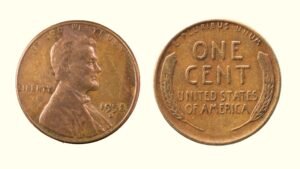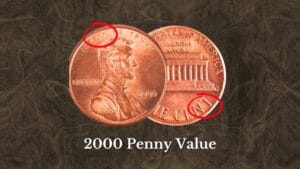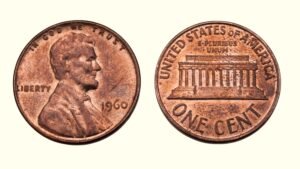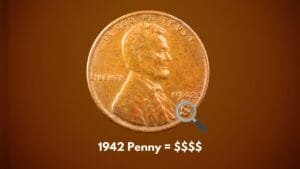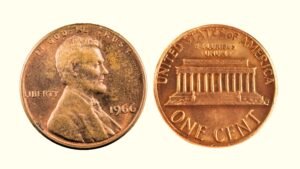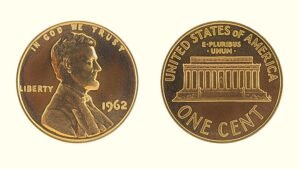Did you know that a rare 1958 Lincoln Wheat Penny sold for an astonishing price of $336,000 in a coin auction? Now, imagine finding such a valuable penny in your pocket change!
As the last year of the Wheat penny design, the 1958 Lincoln penny holds a special significance for collectors and history buffs. In this article, you’ll learn about exploring rare mint marks, valuable errors, and the factors that can manifold the value of your coin!

1958 Lincoln Wheat Penny History
The 1958 Lincoln Penny is the last cent of the Wheat Penny series that began in 1909 to commemorate the centennial of Abraham Lincoln’s birth. By 1958, the series had been in circulation for nearly five decades.
The 1958 penny marked the end of the Wheat penny era, as the U.S. Mint transitioned to the Lincoln Memorial design in 1959. As the series’ last coin, this small cent is highly collectible and sought after by coin collectors.
| 1958 Lincoln Wheat Cent | Key Features & Facts |
| Coin Composition | 95% Copper, 5% Tin and Zinc |
| Minting Location | Philadelphia, Denver |
| Minting Year | 1958 |
| Face Value | 1-cent (0.01$) |
| Weight | 3.11 grams |
| Diameter | 19.05 mm |
| Thickness | 1.52 mm |
| Designer | Victor David Brenner |
| Mint Marks | D – Denver Mint, No Mint Mark – Philadelphia Mint |
| Total Mintage | 1,062,234,820 |
Identifying a 1958 Lincoln Penny Design & Composition
You can easily spot a 1958 Lincoln penny with its distinct design on both sides and its composition and specific dimensions.
1958 Lincoln Penny Obverse:

- A right-facing profile of Abraham Lincoln
- The words “IN GOD WE TRUST” above Lincoln’s head
- The inscription “LIBERTY” to the left of Lincoln
- The mint date “1958” written to the right of the portrait
- The designer’s initials “V.D.B.” for Victor David Brenner on Lincoln’s shoulder (may be difficult to see)
1958 Lincoln Penny Reverse:
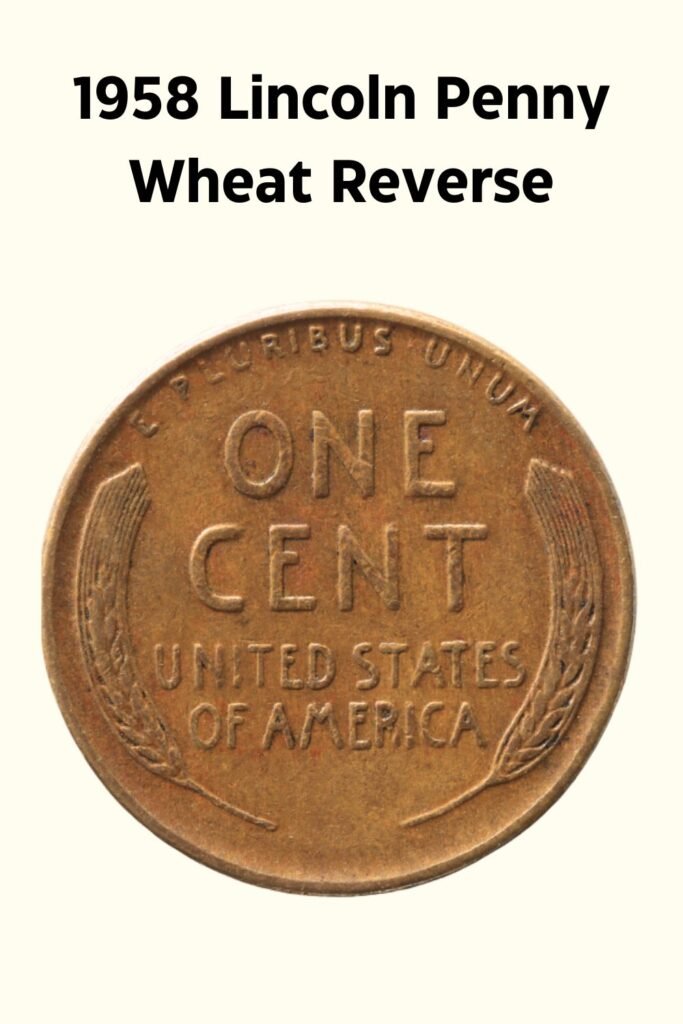
- Denomination “ONE CENT” at the center
- Two wheat stalks encircling the words “ONE CENT”
- “UNITED STATES OF AMERICA” along the top
- The words “E PLURIBUS UNUM” at the bottom.
Coin Composition & Dimensions
The 1958 Lincoln penny is composed of 95% copper and 5% zinc, giving it a distinctive reddish-brown color (when new). The coin weighs around 3.11 grams, has a diameter of 19.05 millimeters, and a thickness of 1.52 millimeters. The edge of the coin is plain, which is a unique characteristic of Lincoln pennies.
Finding the Value of 1958 Lincoln Penny (ALL Factors)
A 1958 Lincoln Penny in circulated condition is generally worth about 1 to 10 cents. However, circulated pennies or those with rare features, like mint errors or rare mint marks, can be worth up to a few thousand dollars.
1. Coin Grading and Condition
The condition of a 1958 Lincoln penny is the most crucial factor in assessing its worth. The coin’s condition is professionally graded on a scale ranging from PO-1 to MS-70, with MS-70 being a perfect, flawless coin.
For 1958 Wheat pennies, the coins in MS-67 and above grades are significantly more than those in lower grades like MS-61 or MS-63 and those in almost circulated condition.
2. Coin Toning & Color
The color and toning of a 1958 Lincoln penny, which is a result of oxidation over time, can also influence its final value. Generally, pennies are graded in three categories based on the amount of discoloration.
- Red (RD): 1958 pennies graded RD have about 95% of their original red luster. These are the most collectible and valuable coins, with lower mint-grade examples fetching $10 – $20 and high-grade examples reaching up to 10,000!
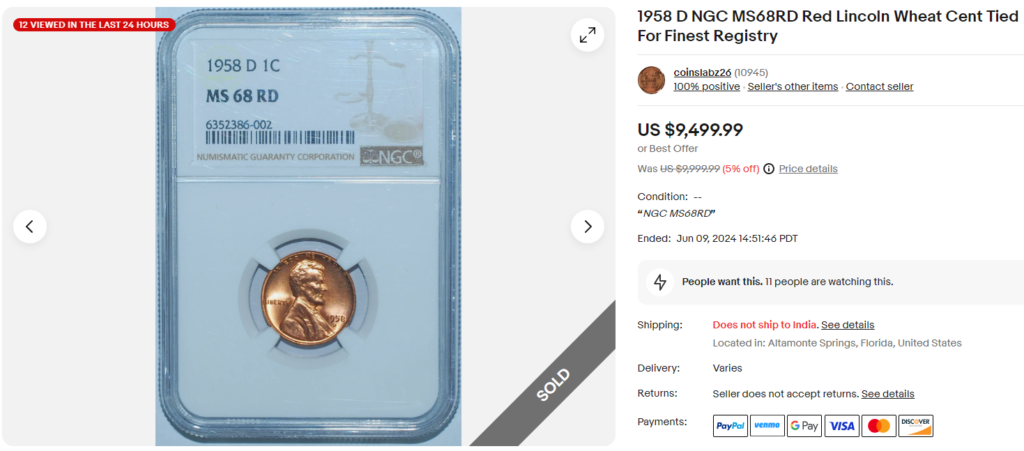
- Red-Brown (RB): These cents display a mix of red and brown hues. They are less valuable than pure red coins but can still fetch a decent price, often around $5 to $15 in low-grade mint condition.
- Brown (BN): Coins that have turned completely brown due to oxidation are graded BN and are generally the least valuable. They are often worth only a few cents, though those with attractive toning can still fetch a decent price.
3. Mint Marks & Mintage
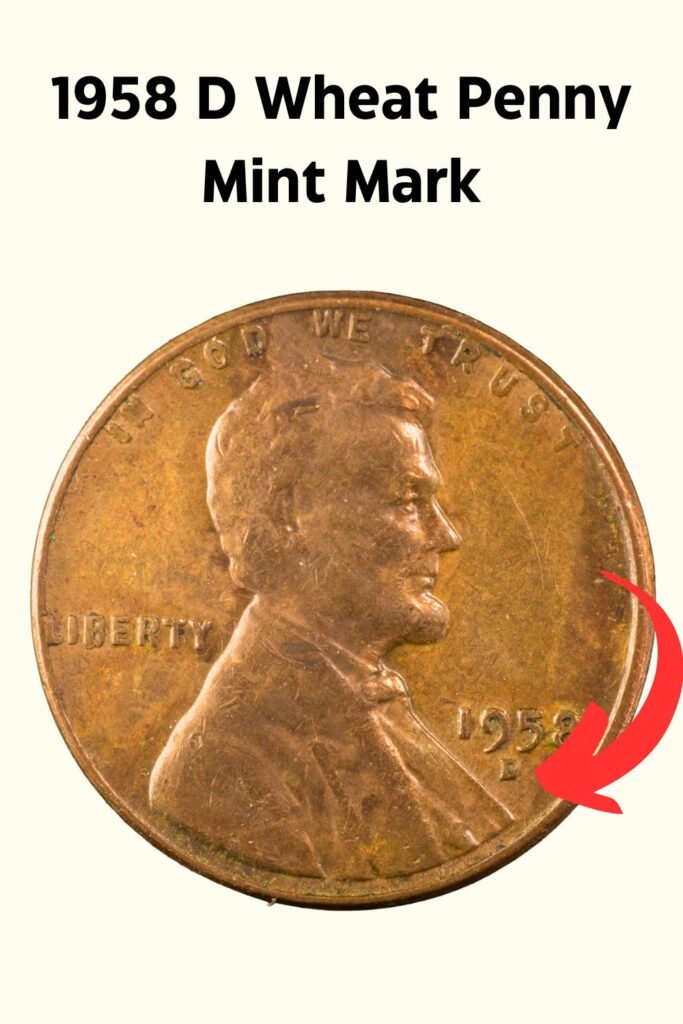
The mintage of a coin decides how rare a coin is. The total mintage for the 1958 Lincoln penny was over 1 billion coins, which makes it quite common. However, pennies from certain mints can be rarer than others.
The 1958 Lincoln penny was minted at three different facilities: Philadelphia, Denver, and San Francisco. You can identify the location with the mint mark present on the obverse.
- 1958 No Mint Mark Penny: The Philadelphia Mint produced around 252,525,000 wheat pennies in 1958, identified by no mint mark. In average conditions, these pennies are worth the face value, but uncirculated coins can reach up to $10 or more.
- 1958 D Wheat Penny: The Denver Mint struck over 8 million 1958 pennies, which made them more common and less valuable. The value of a 1958 D Wheat penny in high-grade uncirculated condition ranges from $300 to $3,000! One of the rarest pennies, MS-68 graded 1958 D Wheat Penny, once sold for over $9,500 on eBay!
You can refer to this 1958 Lincoln Cent value chart to find its average value based on grades (for red coins) and mint marks.
| Coin Grades | Condition Details | 1958 No Mint Mark Penny Value | 1959 D Wheat Penny Value |
| Poor (0) to Extremely Fine (XF45) | Significant wear, faded but visible details | Face Value | Face Value |
| Almost Uncirculated (AU50) to Mint State (AU58+) | Slight wear on highest points, visible marks or blemishes | 20 cents to 50 cents | 10 cents to 30 cents |
| Mint State (MS60 – MS64) | Uncirculated with minimal wear | $3 – $15 | $2 – $10 |
| Mint State (MS65 – MS66+) | Nearly flawless with very minor imperfections | $15 – $100 | $10 – $55 |
| Mint State (MS67 – MS67+) | Well-preserved with no major flaws | $350 – $7,500+ | $150 – $3,000+ |
| Mint State (MS68 or Above) | Nearly perfect, luster, no major marks or flaws | N/A | N/A |
4. 1958 Lincoln Penny Proof Coins
If a 1958 Lincoln penny has a proof finish, it can be more valuable. The United States Mint produced around 875,652 proof 1958 wheat pennies at the Philadelphia Mint (hence, no mint mark), featuring a higher quality mirror-like finish.
The 1958 proof cents are also classified into three designations based on the finish:
- Regular Proof Coins (PR): The standard 1958 proof pennies feature a regular mirror-like surface against the frosted raised design elements. Their values range from $5 to $120, with highest-grade (PR-69) examples fetching up to $500 or more.
- Cameo (CAM) Proofs: Some 1958 proof coins display a stronger contrast between the frosted design and the shiny background, known as “Cameo,” than regular proofs. These can be more valuable, with prices often exceeding $50 for well-graded examples.
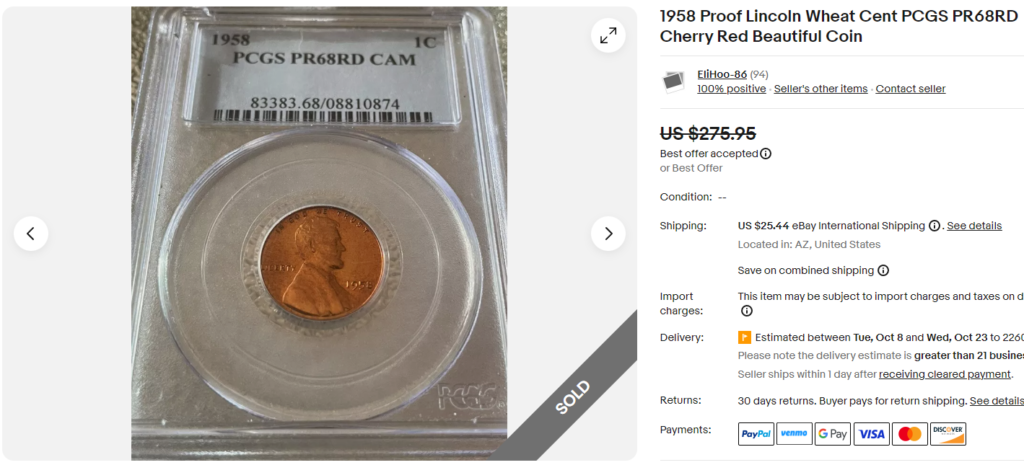
- Deep Cameo (DCAM) Proofs: The proof coins feature the strongest contrast between the background and the raised design and are the most collectible ones. While PR-68 examples can sell for up to $7,000, PR69DCAM 1958 1C coins can fetch up to $50,000, like this one example sold for an eye-popping price of $50,400 on Stack’s Bowers!
5. Most Valuable 1958 Wheat Penny Errors
Minting errors can significantly increase a 1958 Lincoln penny value. Here are the most popular and valuable mint errors to find on a 1958 penny:
Double Die Obverse (DDO)
This error occurs when the die is misaligned, resulting in a doubling effect on the date and inscriptions and striking the same doubled image on the 1958 penny. To spot this error, look for doubling in the lettering of “LIBERTY” and “IN GOD WE TRUST,” the mint year, and Lincoln’s portrait.
Depending on its condition, a 1958 DDO penny can be worth hundreds to thousands of dollars. The auction record price of an MS-64 RD example with DDO error is a whopping $336,000 on Stack’s Bowers!
Off-Center Strikes
If a 1958 Lincoln Cent was not aligned correctly during minting, it could be struck off-center with a part of its design missing. Depending on the coin’s color and condition, a 1958 penny with this error can sell for $100 to $450 or more.
For example, I found an MS-64 penny with a 60% off-center design that sold for over $310, while an MS-63 example with a 20% off-center strike sold for over $430!
1958 D Penny Repunched Mintmark (RPM)
This error results from the mintmark (D) being struck multiple times on the 1958 Lincoln Wheat Cent, creating a blurry or doubled appearance. A 1958 penny with RPMs can be worth $50 or $200 or more for higher-grade coins and more prominent doubling.
Overstruck on a Cuba Centavo Blank (Wrong Planchet Error)
This rare coin is a result of a 1958 cent getting struck on a Cuba Centavo planchet. You can spot this by its smaller size, causing a partial outer design (including the letter “L” of Liberty) to cut off. Due to the blank’s composition, this error coin also weighs and measures differently than a regular 1958 penny.
Extremely rare to find, an MS-65 example of this error coin sold for $1,527 on Heritage Auctions! Only very few such coins have been discovered to date.
Struck on a Dime Blank
Like the previous error, this one has a 1958 Lincoln Wheat Cent struck on a Dime blank. To identify this rare coin, observe its color; it would be gray rather than red or brown. The size and weight of the coin will also be different. An MS-63 graded 1958 1C dime coin once sold for $940 in a coin auction!
How to Spot a Fake 1958 Lincoln Wheat Cent
To find out if your 1958 Penny is real or fake, follow these four steps:
- Check the Weight: A genuine penny should weigh close to 3.11 grams. Use a precise scale to weigh your coin; if the weight is significantly off, it could be a fake.
- Verify the Size: Use a caliper to measure your 1958 penny carefully. If its thickness and diameter are larger or smaller than the specific dimensions, it’s fake.
- Examine the Edge: Use a magnifying glass to observe your penny’s edge. The edge of a real 1958 Lincoln penny is plain. If yours has any unusual markings, reeding, or breaks, it’s a counterfeit.
- Look for Mint Marks: If you have a 1958 D Penny, verify the presence of the mint mark. Check if it matches the style, size, and font of the real pennies.
- Check the Composition: A real 1958 penny is made of copper (95%) and isn’t attracted to a magnet. If your coin reacts near a magnet, it indicates it is not real.
If you’re still unsure, compare your coin with genuine graded examples or contact a professional grading service or numismatist to authenticate your coin.
Note: This article is intended for informational, educational, and entertainment purposes only. Some images are illustrative and may not represent actual brands, products, or related entities. All trademarks, product names, brand logos, packaging, and other intellectual property referenced remain the exclusive property of their respective owners. Any brand mentions or references are provided solely for descriptive and educational context and do not imply any formal or commercial association.

